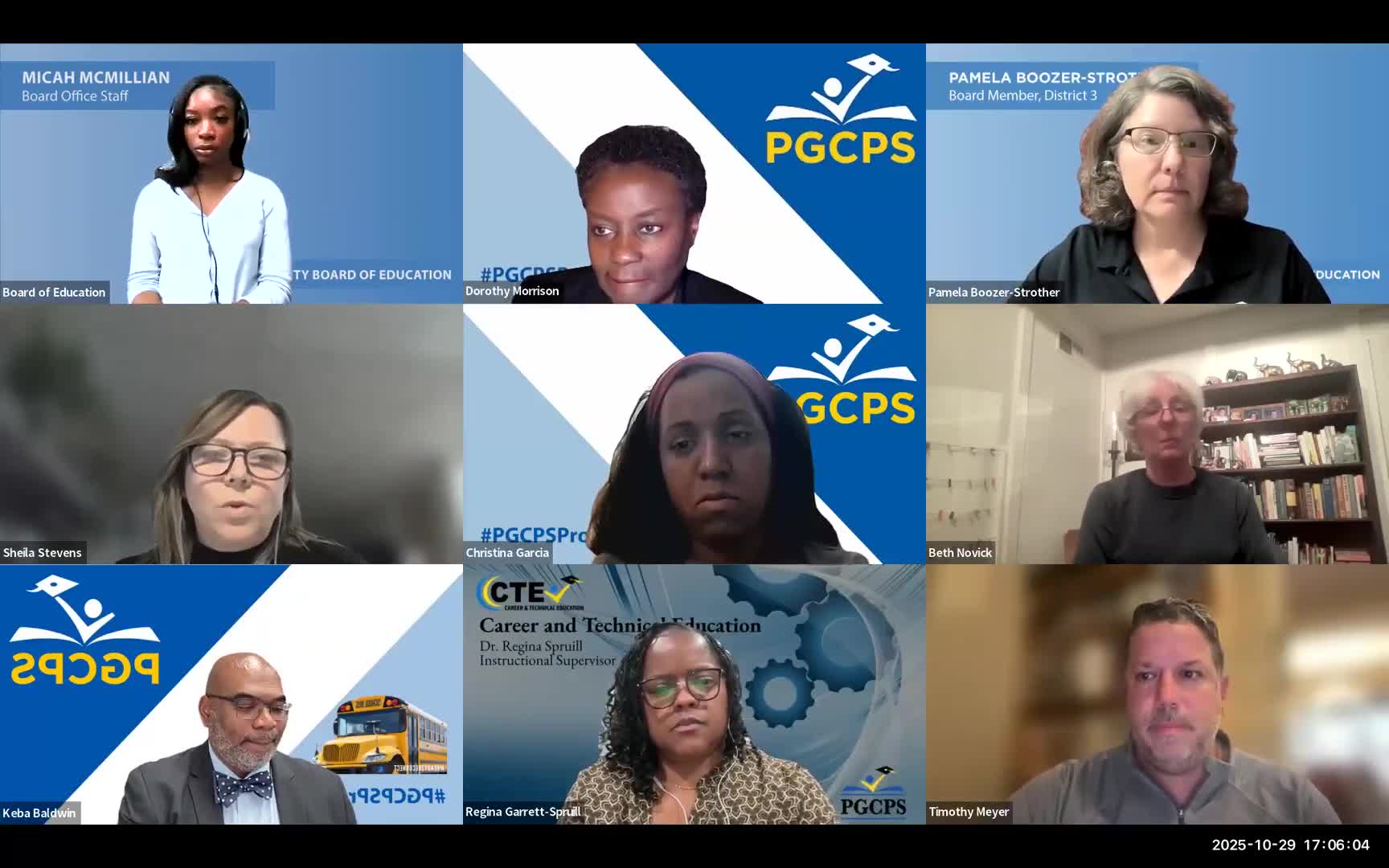PGCPS: six Phase 1 P3 school solar installs near energization; district plans RFP after market RFI
October 30, 2025 | Prince George's County Public Schools, School Boards, Maryland
This article was created by AI summarizing key points discussed. AI makes mistakes, so for full details and context, please refer to the video of the full meeting. Please report any errors so we can fix them. Report an error »

Sheila Stevens, a PGCPS program manager in the Department of Sustainability and Resilience, told the Climate Change Action Plan Ad Hoc Committee on Oct. 29 that five of the six Phase 1 P3 middle-school rooftop solar installations are progressing and that the district expects panels at several schools to be energized over the coming months.
"They're expecting energize, inner for the school to be energized, in December, hopefully. Fingers crossed," Stevens said while showing photos of rooftop equipment staged and crews working.
Key details: Stevens provided school-specific updates: Colin Powell and Film Bridal schools reported rooftop equipment staged and module installation underway with anticipated energization in December; Drew Freeman and Sonia Sotomayor middle schools expected energization in late January or early February; Kenmore Middle School is slightly behind schedule and expected in early February. Stevens reported she is following up on Walker Mill, which was awarded an MEA solar grant (reported value: $396,000) and requires reporting to the grantor.
Procurement next steps: Stevens said the district issued a public RFI over the summer and extended its response window through Oct. 20 to capture federal policy changes that shifted the market. District staff will analyze RFI responses and work with purchasing and procurement to design an RFP intended to create a pool of prequalified solar installers the district can call upon rather than handling each contract ad hoc.
What solar powers: Stevens explained the current Phase 1 projects are being financed under power-purchase agreements in which the district will buy energy from the installer rather than own the panels. "We're not taking ownership of the panels. We're basically leasing them for the next 15 to 20 years," Stevens said. She noted that owning versus PPA has trade-offs and that phase‑2 schools are being designed with ownership as an option.
Follow-up questions: Committee members asked about the magnitude of expected cost savings and whether production will be credited directly to individual school loads; Stevens said she will follow up with more detailed cost and performance data once production records are available.
Why it matters: On-site solar reduces grid electricity use at schools, contributes to the district's greenhouse-gas accounting and is part of PGCPS' broader climate goals. The RFI/RFP work is meant to standardize vendor selection and accelerate additional installations.
Provenance: Stevens' updates and the Walker Mill MEA grant were reported during the district's renewable energy presentation.
"They're expecting energize, inner for the school to be energized, in December, hopefully. Fingers crossed," Stevens said while showing photos of rooftop equipment staged and crews working.
Key details: Stevens provided school-specific updates: Colin Powell and Film Bridal schools reported rooftop equipment staged and module installation underway with anticipated energization in December; Drew Freeman and Sonia Sotomayor middle schools expected energization in late January or early February; Kenmore Middle School is slightly behind schedule and expected in early February. Stevens reported she is following up on Walker Mill, which was awarded an MEA solar grant (reported value: $396,000) and requires reporting to the grantor.
Procurement next steps: Stevens said the district issued a public RFI over the summer and extended its response window through Oct. 20 to capture federal policy changes that shifted the market. District staff will analyze RFI responses and work with purchasing and procurement to design an RFP intended to create a pool of prequalified solar installers the district can call upon rather than handling each contract ad hoc.
What solar powers: Stevens explained the current Phase 1 projects are being financed under power-purchase agreements in which the district will buy energy from the installer rather than own the panels. "We're not taking ownership of the panels. We're basically leasing them for the next 15 to 20 years," Stevens said. She noted that owning versus PPA has trade-offs and that phase‑2 schools are being designed with ownership as an option.
Follow-up questions: Committee members asked about the magnitude of expected cost savings and whether production will be credited directly to individual school loads; Stevens said she will follow up with more detailed cost and performance data once production records are available.
Why it matters: On-site solar reduces grid electricity use at schools, contributes to the district's greenhouse-gas accounting and is part of PGCPS' broader climate goals. The RFI/RFP work is meant to standardize vendor selection and accelerate additional installations.
Provenance: Stevens' updates and the Walker Mill MEA grant were reported during the district's renewable energy presentation.
View full meeting
This article is based on a recent meeting—watch the full video and explore the complete transcript for deeper insights into the discussion.
View full meeting
